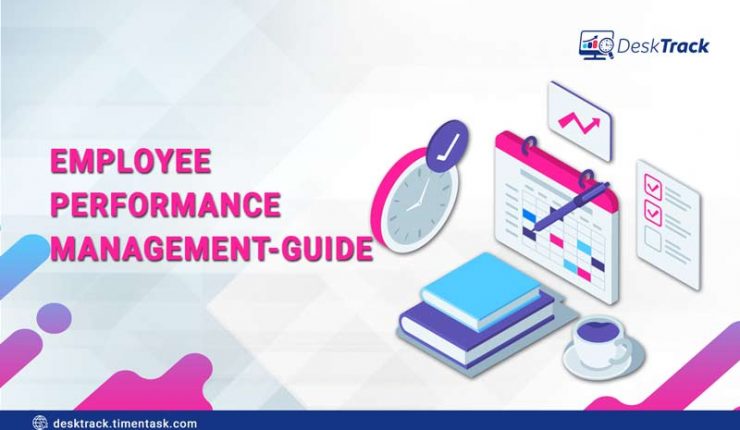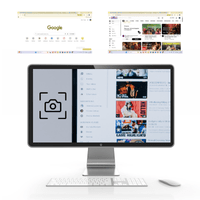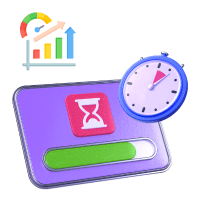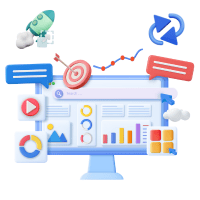
Chapter-1
Performance Management Introduction
To manifest “Employee Performance Management” effectively in your space, whether it is your organization, public space, etc is a task on its own.
Here in this blog, you are going to learn to implement all the aspects of performance management which includes – Introduction, Performance Management Practices, Annual Performance appraisal and Performance management (difference and outcomes of it), Stages of the performance management cycle, signs of poor performance management process, examples of employee performance management and Performance management tools.
Gone are the days when employees’ expectation from an organization related to growth was only limited to yearly appraisals. However, nowadays if a well-planned and executed employee performance management system doesn’t exist in the organization, then employee engagement and employee retention become a hard nut to crack.
Considering the competition existing in the market, companies ranging from small to medium, medium to large, Fortune 500 companies, etc are adopting this new dynamic and strategic approach.
What is Performance Management System?
Before all of the above, we should know first what is employee performance management system is. Performance management is a monitoring and evaluation tool for employees’ work required by managers/supervisors in corporate management. Employee Performance management tools are required so that the employees can perform best of their ability and deliver high-quality performance work.
The main agenda of performance management and employee engagement is accountability, transparency, and a clear understanding of expectations between the employer and employee. Research has shown that companies that prioritize employee engagement through effective performance management not only have more productive and satisfied employees but also enjoy the better financial performance in the long run. It is about synchronizing employees’ work with the organization’s expectations and goals and also with employees’ career progress.
Managers/supervisors can use this tool to adjust the workflow of their employees, recommend a new course of action and take decisions that help employees to achieve their objectives.
Importance of Employee Performance Management
Is performance management important? If yes then Why is performance management important?
Effective performance management programs help develop a mutually beneficial relationship between the organization and employees. As per a study by Valamis, employees are likely to enhance their performance by 50% if they get to review their organizational goals at least once in each quarter.
The following are the points to emphasize the importance of performance management:-
-
Keeps Employees Engaged
When employees are clear about their set goals and objectives, they tend to be more engaged in accomplishing them.
-
Retains Talent
An effective performance management program not only attracts talent but also proves to be in favor of retaining them for a longer period of time as employees in such cases find themselves empowered by the organization.
Read more on Employee Retention – How to Bring Employee Retention in Your Organization without Money?
-
Develops Leaders from within
Employee performance management not only brings employees’ performance on track but also prepares leaders amongst them.
The Employee performance monitoring tool can also be used to assess a variety of Key Performance Indicators (KPIs) for employee performance, hence identifying potential leaders within the organization. This way you can save on external recruitment for candidates who possess leadership skills.
-
Provides an Opportunity for Feedback
Besides the organization analyzing employees’ performance, effective employee performance management also provides employees an opportunity to share feedback regarding their concerns and issues in their workplace or process related to it.
-
Detects Potential Problems
Since assessing KPI is a part of employee performance management, this leads managers/supervisors to know the weaknesses and strengths of their employees.
Especially, when it comes to weaknesses, this helps managers to either train or replace the relevant employee so that any sort of potential problem can be detected beforehand and prevented from becoming a problem in real.
-
Boosts Employee Engagement
Whenever there is a disconnection between employees and management, employees are less likely to engage in work as well as with the organization.
On the other hand, when the organization gives an employee enough reasons like an effective performance management solution to engage in their work in such a way that the employee feels invested in the company by working on clear and concrete goals and objectives, it then gives rise to employee satisfaction too.
Read more on employee engagement – How to Measure Employee Engagement in the Workplace?
Employee Satisfaction – Difference Between Job Satisfaction and Employee Satisfaction
-
Create a Scope for Rewards and Recognition
Where there are discussions on employee performance, there is feedback, and where there is feedback there comes the scope of employee recognition and rewards too which not only gives the employee a sense of belongingness but also encourages the employee to be more productive and engaged at the workplace.
-
Identify Training & Development Opportunities
Through performance development programs, your human resource team also gets a fair vision as to how to improve more on employees’ skills and boost their performance by planning and conducting relevant training and development programs.
What are the Components of Performance Management?
The 5 components of performance management are as follows:
-
Planning
The process of planning includes setting performance expectations and including employees in the process to deliver a better understanding of organizational goals – what needs to be done, why it needs to be done, and the scale of efforts required to achieve the goal.
It also includes setting standards and elements for performance appraisal plans, keeping in mind that performance elements standards should be measurable, understandable, verifiable, equitable, and achievable.
-
Monitoring
It is a process of measuring the performance delivered on projects and assignments and providing relevant feedback to employees or work groups on their progress in achieving the organizational goals.
It also includes the process of checking if the set performance standards and elements are realistic or unrealistic while meeting the goals and targets.
Such monitoring also includes identifying unacceptable performance and addressing it at the same time instead of waiting until the end of the appraisal period when the performances of the workforce are rated.
-
Developing
It is the process of evaluating and addressing the developmental needs of employees.
It also means upgrading the skills of employees through training and developmental programs to encourage good performance, enhancing the competencies and hence adapting employees to changes taking place in the workplace due to the advancement of technology or any new working model.
-
Rating
It goes without saying that once monitoring of performance is done, rating of record possesses its own importance as it is a crucial part of an organization’s appraisal program. The rating of the record is decided based on employees’ performance delivered during an appraisal period.
The rating of record also has a bearing on other relevant grants and pays offered to an employee, ex-increment within grade pay, additional retention service credit, etc.
Note – Rating of the record is only assigned to individual employees and not to any group par says.
-
Rewarding
Rewards are more than regular salary or compensation was given to an employee of an organization. Rewarding an employee means acknowledging and recognizing the contributions made by the employee not only in terms of performance but also in terms of his integrity, engagement, and retention for a considerable course of time.
It is a day-to-day process in an organization to boost employees’ morale and confidence in work. The various forms taken by reward are in the form of ‘thank you’, time off, and various nonmonetary items.
What are the Factors that Influence Employee Performance?
It is said that to bring improvement to a system or organization, problems or factors causing certain problems need to be figured out. Therefore, speaking of employee performance management, let us know the factors influencing the same:
1. Management Style
As per a study by Gallup & Udemy, there exists a direct link between poor management and poor performance. Therefore, in order to improve performance, one way is to identify and fix the problems in management.
Also, employee surveys can pinpoint issues existing in management and suggest avenues for improvement accordingly.
2. Corporate Culture
Organizational culture is composed of beliefs and assumptions, held by employees of the organization. Positive beliefs result in good performance whereas negative ones hardly bring any good results in employees’ performance.
For instance, the following traits in employees can bring good results in performance:-
- The practice of continual learning and improvement
- The practice of digital literacy and digital dexterity
- Open to new ideas and paradigm shift
3. Digital Work Environment
The digital work environment of an organization consists of digital Employee Performance management tools used by employees, how these digital tools are being used, digital training, and digital workflows.
The more an organization invests to develop a digital work environment, the more upskilled and updated its employees are.
4. Physical Work Environment
The physical work environment influences employees’ metrics, engagement, and performance at work in the end. The better the work environment from desk to decor, the better an employee tends to perform.
5. Employee Experience
It includes all the below points as an employee journey –
- Hiring
- Onboarding
- Engagement
- Post-Exit Interactions
Many organizations have this belief that an employee’s experience has a direct role in how much value he contributes to the organization.
6. Employee Onboarding
It forms the initial step of an employee’s journey in an organization.
In order to ensure an effective performance at work from the beginning of the employee’s journey in the organization, the latter should ensure to follow the below checklist:-
Operational Integration – The employee should be handed with appropriate Employee Performance management tools, skills, and resources he needs to succeed at the job.
Liaisoning – Social integration with coworkers and another workforce in the management.
Strategic Integration – To align an employee’s intent of work with the company’s mission and goal so that he remains focused and delivers the best of his performance.
A quick integration by the employee leads to better employee engagement, satisfaction, and hence employee retention for long.
Benefits of Performance Management For Employees
“All organizations are perfectly designed to get the results they are now getting. If we want different results, we must change the way we do things.” – Tom Northup
-
Improved Employee Engagement
An effective performance management strategy leads to a better understanding of work and goals to be achieved, hence leading to voluntary employee engagement.
-
Reduce Time & Effort
Performance management reduces the time and effort required for supervision by explaining why and what employees need to do when a task is delegated to them.
Also, this reduces the need for disciplinary action.
-
Better Talent Retention
An effective performance management strategy also covers ways for talent retention.
Talent retention comes from the fact that the employees feel valued, upskilled, recognized, and engaged in the organization they are working in.
-
Justification
Performance management also makes it easier to implement hard decisions about employees. In case, an employee needs to be fired then the procedure of documenting problems and communicating the same to employees makes it easier.
So, whenever the employee files a complaint, the documentation prepared by the senior management can show that the decision was based on performance issues wherein the employee is aware of the same. In fact, solid employee performance management documentation can sometimes keep frivolous lawsuits and complaints at bay.
Chapter- 2
Best Performance Management Practices
18 Best Performance Management Best Practices
Let’s learn more about “how to manage employee performance- Best Practices”
1. Know your Goals for Performance Management Initiatives
Before you finalize on your performance management program, you need to know what you want to accomplish.
You can answer the following questions yourself:-
- Is an increase in productivity your priority?
- Is your organization looking forward to identifying leaders from within and developing them?
- Do you plan to improve employee retention or engagement?
Knowing what you want your program to do would help you accomplish your goals at a fast pace.
2. Monitor Progress on Performance Targets
Reviewing key areas of performance is a significant part of monitoring as a process.
Also, you can seek advantages from metrics and analytics and track the progression of goals so that any intervention if required can happen early.
3. Provide Guidelines to Employees
It becomes easier to keep track of and analyze performance when employees work on guidelines.
It should be created for each role in the form of the first stage of the performance management cycle.
4. Plan cross-functional workshops
There is no harm in learning from others. You can organize cross-functional workshops so that your department can get to learn from other departments and their performance-enhancement strategy.
Also, such strategies help them build new connections which can be useful for some future work.
5. Conducting Continuous Performance Management Meetings
In order to bring efficiency, alignment and engagement in your team, one-on-one meetings work wonders. It is best if such meetings can happen once in a week, if not then such meetings must be scheduled monthly.
6. Prioritize Collaboration and Frequent Goal Setting
Managers or team leaders should not set goals alone but include their entire team to achieve the organizational goals.
Besides, frequent meetings should be conducted either weekly or biweekly as suitable to achieve a bigger goal by stepping in small stones.
7. Practice Employee Recognition
The more an employee is recognized for his efficiency in work, and valued behavior in the workplace, the more he is likely to deliver the best of his performance in work which is also called employee engagement and performance management in other words.
8. Regular Performance Feedback
The culture of regular and genuine feedback helps employees to boost or catalyze their performance. Also, such a culture fosters trust in employees’ minds towards the organization as a whole and helps bring performance management and employee retention in the end.
9. Keep your Feedback Professional and not Personal
The question arises how can managers improve employee satisfaction with the feedback process? Providing feedback to employees on a regular basis is a good practice of performance management.
However, this needs to be ensured that the feedback should sound professional and not point toward the characteristics of an employee.
Example – If David generally delays submitting monthly reports, then the feedback should not sound like David is a lazy man but it should speak about his behavior of submitting reports late.
10. To only Train Employees is a Myth
Managers and team leaders should also go through coaching and training on how to provide effective feedback, how to lead well, etc.
11. Fair Performance Evaluation
In an organization where performance evaluation is fair and inclusive, its employees are more likely to engage. The managers or leaders should call for honest feedback from their employees regarding evaluation so that they can strive towards better improvement in their work performance.
12. Don’t consider Employees as the only Root of Problems
Lack of performance is not always because of employees but other external factors too – availability of supplies, internal issues in the organization, or organizational policies.
Therefore, try to figure out such problems and mitigate them before it gets too late in order to do effective performance management.
13. Aligning Employee Performance with Organizational Goals
Team leaders or managers should ensure to show the big picture of efforts put in by their employees as in how it would affect the outcomes of the entire organization as a whole.
This practice is necessary to align employee performance with organizational goals.
14. Start Setting SMART Goals
If goals are not defined properly, then it can lead to poor performance. This is to ensure that employees’ goals are defined in a SMART way where S stands for Specific, M stands for measurable, A stands for actionable, R stands for relevant, and T stands for time-bound.
Such a strategy of goal setting brings a sense of ownership, clarity and commitment in employees’ minds.
15. Keep Faith in Your Employees
This is one of the success factors on every level.
As the remote working mode is more prevalent these days, therefore there are chances of some employees not being able to meet up to the deadline of their work. So, in such a situation, doubting their professionalism can leave them underestimated.
On the other hand, if you keep faith in your people, it would not only enhance respect towards the organization but would also encourage them to engage in their work more which is a likely situation to deliver an outstanding performance.
16. Implement OKR methodology
OKR stands for “Objective & Key results” methodology wherein the management can set, communicate and track progress on organizational goals.
This method brings accountability and quantifies the accomplishments toward organizational goals.
17. Technology Role
Integrating performance management with core HR programs with the help of technology integration is also one method of performance management.
This approach allows for quantification, analysis and impact to be calculated more quickly.
18. Standardize and Automate the Process of Performance Management
All employees should follow the same standard of the performance management process. In the case of a large number of employees, automated solutions can be used to generate performance reviews as a set process.
Chapter – 3
Annual performance Appraisal & Performance Management
1. Difference between performance appraisal & performance management
Performance appraisal involves the process of evaluating an employee’s performance on the basis of his previous performance.
On the other hand, performance management involves proactively managing the employee’s performance in order to achieve organizational goals, vision, mission and core value.
| S.No. | Performance Appraisal | Performance Management |
| 1 | It involves the evaluation of previous tasks and feedback on how some current task is performed.
It doesn’t involve a strategy for future growth. |
It involves the process of expending time and resources on employees to achieve organizational goals and mission. |
| 2 | It is an objective evaluation done on an employee’s performance for a given year along with sharing final feedback. | The process checks whether an employee has achieved a set number of goals or not.
Also, it guides the employee to deal with the blockers on the way. |
| 3 | It is merely an evaluation of the employee’s mistakes and communicating how he could have done better. | It is a sort of guidance to the employee so that he can perform better in the future. |
| 4 | It doesn’t take place more than twice a year. | Since it is a continuous process, therefore, it is involved in day-to-day conversations between a manager and an employee. |
| 5 | Performance appraisal typically involves a quantitative approach. | Performance management involves both quantitative and qualitative approaches in order to enhance employee performance. |
| 6 | It is more often taken care of by the HR department. | Performance management is majorly taken care of by managers, supervisors, and other relevant stakeholders. |
| 7 | Performance appraisal is usually considered to be inflexible. | It is relatively flexible. |
| 8 | It is an operational tool to increase employees’ efficiency in performance. | Performance management is more of a strategic tool |
The similarities between performance management and performance appraisal are that both processes include setting targets and clear expectations.
2. Outcomes from Annual Appraisal and Performance Management
-
Outcomes from Annual appraisal
1. Final Rating for employees
It is one of the outcomes of performance appraisal wherein there is elaborate detailing on the compensation of employees.
2. Minimize competency gaps
It reduces an employee’s competency gaps which further leads to suggestions on areas of improvement.
3. Identify high-potential employees
Performance appraisal brings the identification of high-potential employees which helps in succession planning for an organization.
4. Training requirement
Performance appraisal provides a significant outcome on requirements of training and skill upgradation of the workforce so that the training department can plan its calendar accordingly.
To put it in nutshell, the outcome of performance appraisal helps in Compensation Management, Succession planning, and planning for training and other certifications.
-
Outcomes from Employee Performance Management System
1. Everyone is aware of the rules
A well-structured Employee performance management system brings easy-going communication between a manager and an employee. This results in proper assessment of the employee’s tasks as they are very familiar with the criteria to assess employees’ performances. Also, the employee on the other hand is clear about his goals and targets to be achieved.
2. Habit of Recording Opens up Communication
If an organization inculcates a habit of maintaining a performance diary, then both the employee and the employer are ready with relevant content to discuss with each other performance and organizational goals.
3. Rise of Employee Learning & Development Culture
An effective performance management plan makes employees and the manager commit to a development plan, employees go through personal development and hence find themselves more engaged in the organization.
Chapter – 4
Stages of Performance Management Cycle
Four key stages of the Employee Performance Management Cycle

1. Planning:
The planning phase is a crucial stage for performance management which includes setting performance expectations for an
employee. Such expectations are often planned and are also included in the job descriptions for the candidate or a prospective employee.
It is considered to be one of the best practices to actively involve the employee in the such a planning process. According to an analysis by Cawly, Keeping & Levy (1998), this sort of involvement often increases employee engagement, as well as the notion of fairness, relevance, and motivation to improve.
Additionally, employee performance plans should be flexible enough so that they can be adjusted to changes in objectives and requirements over time.
2. Monitoring:
This phase includes nothing but an active track of the goals set in the planning phase. This phase is all about continuous measurement of employee’s performance and sharing feedback on progress as one is striving towards the goal.
By continuous monitoring, the respective manager or supervisor can bring corrections in case of deficient performance, instead of figuring this out at the end of the year when it is very late.
Especially when it comes to dealing with highly educated professionals, the goal as a result matters the most instead of how it is achieved.
Micromanagement should be avoided from the managers’/supervisors’ end but most of the time should be invested in determining exactly how a goal has to be achieved. Good performance management practices become one of the reasons when it comes to effective monitoring.
3. Developing:
Development plays a vital role in improving an employee’s performance. Active monitoring brings out areas of improvement in an easier way.
It can be either underperformance that needs to be corrected or areas of superior performance in which the employee aspires to excel more.
This can be achieved through some necessary training and development programs.
Additionally, it can also be achieved through challenging assignments and other opportunities for personal and professional growth.
4. Rating & Rewarding:
Rating performance is meant for determining the contribution made by employees to the organization.
This is often done during the employee’s annual performance appraisal. In case of continuous poor performance, the employee seems to disappoint the organization’s expectations, and usually, the parties tend to say goodbye to each other. In case of outstanding performance, the employee is recognized for his contribution and dedication towards the organization.
Rewards can take many forms such as praise, a raise, time off, recognition items, a promotion, or maybe all!
Chapter – 5
Signs of Poor Performance Management Process
Top 7 signs of Poor Performance Management
1. No Idea of Accountability:
Employees are hardly aware of the accountability for managing poor performance. They have no idea whether it is the HR department, their manager or peers, or themselves.
Though conventionally, only managers were responsible for performance management which unfortunately led to biased opinions and poor performance.
However, nowadays employees hardly work in isolation as there are many interdependencies within a team. Therefore, the responsibility does not lie on one person alone. Every member needs to play some role in the performance management process, irrespective of how smaller it may appear.
2. Higher Turnover:
If your company has a high attrition or turnover rate as compared to other companies in the same industry, then it’s time to identify the root cause for the same. Mostly, the reason for this is poor performance management of employees in the organization. Below are mentioned 4 reasons for low employee engagement at work:
- Poor recognition at work
- Negligible guidance for growth
- Lack of scope for personal development & growth
- Lack of constructive feedback
3. Excellent Strategy with No Implementation:
Though the top management takes painstaking efforts for creating some good organizational strategy. But does it get executed in a manner imagined by them?
Due to some inefficient performance management processes, employees hardly have any idea how their everyday work or organizational goals contribute to the overall strategy.
Therefore, it is important to reduce the strategy execution gap to ensure that everyone is progressing in the same direction.
The management can seek help from marketing communications tools to craft messages in such a direction.
4. Persistently not Accomplishing Goals
Yet another effect of poor management of employee performance is that there is a lack of persistence in accomplishing goals.
The reason for the same is not always inefficient employees but also a significant mismatch between their goals and actual outcomes due to a lack of communication in terms of conveying clarity of expectations.
Additionally, inefficient goal-setting processes also give rise to such gaps.
In order to bring a solution the management needs to be educated on how to effectively do goal setting and subsequently performance management in the organization.
Refer how Google used the OKR methodology to get efficient at setting and achieving goals. You can refer to and replicate the methodology or set SMART goals to get better.
Hence, you can help your workforce to align their goals with the overall organizational values and eliminate all sorts of misconceptions and confusion.
5. Subjective or Biased Feedback:
A flawed goal-setting process is always led by subjectivity which cannot be measured. Hence, It becomes difficult for managers to quantify performance and come up with objective, constructive, and timely feedback and end up with biased feedback, showcasing the whole process unfairly.
The process of performance management should be developed in such a way that it helps guide employees continuously along with providing steady mentoring and genuine feedback.
Since performance needs to be measured based on facts and numbers, there should be negligible scope for the manager/supervisor to share biased feedback.
Regular performance reviews are the only way that can help managers to figure out poor performers so that they can decide and focus on providing coaching (making sure that they share negative feedback logically and rationally).
When the entire team is assured of the fact that both the manager and the organization are inclined towards their overall growth, the work environment becomes aligned towards growth – and hence both of them strive hard to work on their strengths and overcome weaknesses.
6. Managers feel Vulnerable to breaking the status quo:
Performance management is merely not about a simple box-checking exercise.
Some managers feel vulnerable to breaking the status quo, therefore they find it hard to do the confrontation and blindly follow the process.
But sometimes, poor performance needs to be addressed as poor performance. Without this, performance process management has no sense for existence.
When managers or supervisors find that employees are not giving their best performance as per their potential then it becomes their responsibility on priority to bring them back on track with time-to-time feedback.
Not just fault finding helps but giving inputs on how to overcome such performance problems is important too.
7. Lack of Initiatives for Personal Development:
One of the most important purposes of performance management is to upgrade employees’ skills themselves, by figuring out individual performance problems.
It is as important for them to progress in their career as it is for the organization to achieve its goals.
If employees do not find any growth for themselves in the organization, they prefer to look for better opportunities. No organization or team leader wants the good ones to jump ship.
It is their responsibility as managers/supervisors to ensure that they grow and become a better version of themselves.
Poor performance management can bring huge losses to the organization.
Therefore, it is best to keep a constant check for these signs in the workplace.
Such a focus on making the performance management process fair and transparent play ultimately leads the organization to the next staircase of success.
Disadvantages of Poor Employee Performance Management
1. Employees Leave Due to Unfair Results
When an employee performs well but feels that he was assessed unfairly, there’s hardly any motivation left for him to work any longer with the company which may lead to the following results:
- Such an employee may grow resentment towards his colleagues who he feels were treated more favorably.
- He feels dissatisfied and looks for alternative opportunities around.
- In extreme cases, he may even quit the job even when he doesn’t have some other job in hand.
2. Employee Morale can go south
When an employee starts feeling that he was evaluated unfairly, he tends to become withdrawn and disengaged. Moreover, he is likely to lose self-esteem, which in turn can create resentment towards the management in the organization which as a result reduces employee engagement and leads to lower performance rates.
Therefore, a system that is unfair and invalid, produces dissatisfied employees who feel burnt out in their roles.
3. Resources go Wasted
Preparation for an annual review demands a great deal of time — As per a study by Deloitte, on average a manager spends 210 hours on performance review activities. This is around an extra month to prepare for an annual review.
The present system of performance management is time and cost-efficient as it produces optimal results because issues can be detected and dealt with in a timelier manner.
In case of a poor Employee performance management system, the staff tends to leave which means that time on employees was wasted when they might have to be replaced anyway.
Besides additional time and costs, managers will be compelled to allow their employees to work on peer reviews to prepare for annual appraisals.
Basically, the entire department — or even the whole organization — will be required to go into shut-down mode and keep priority work on the backburner unless yearly reviews are completed.
Do You Know?
According to Betterworks, companies that tend to adopt continuous performance feedback outperformed their competition at a 24% higher rate.
4. Fabricated or misleading information affects the review
Without performance data to justify the appraisal, there is no way to determine whether the appraisal is genuine or not.
To resolve such issues a manager can provide performance information that’s either false or misleading, hence skewing the assessment unfairly.
5. Managers go Frustrated
Poor performance management can turn managers frustrated whenever they observe a lack of employee motivation, complaints, and/or staff eventually leaving.
Besides, management can become unhappy too depending on the poor performance of their business. Sometimes, they may have less of an idea as to how to improve the issue.
6. Compliance Risks
When employees start to feel a major dip in the robust performance management system of the organization, they usually tend to take legal action.
In such a scenario, the judge comes up with a decision that the business has failed to adhere to employment laws which could then result in a fine, or worse.
The compliance risk can take the following forms:
- Regulations or acts
- Non-compliance penalties
- Compliance status
- Risk ratings
- Obligations
Employee Performance management software that is poorly planned and/or implemented may have serious repercussions for a business.
Therefore, It makes more sense to invest considerable time and effort when it comes to planning for a robust performance management system. This may take more of your time and energy as an investment, but it’s worth doing so to reap rewards for your business for years to come.
Chapter – 6
Employee Performance Management Tools
Top 4 Employee Performance Management Tools
1. DeskTrack
The parameters provided to measure performance management for employees are as follows –
-
Robust Attendance Reporting
An individual’s or a team’s performance depends on the time invested in a certain project. The time spent depends on the regularity of attendance in the workforce.
DeskTrack’s robust attendance report gives it all. It shows the login/ logout pattern of employees.
The parameters shown by this report are Total Time spent, Desktop Time, i.e Active time on desktop, Idle Time, Productive Time, Unproductive Time, and Productivity in percentage.
-
Availability Management
This feature shows the leave report for an employee which includes the Total No. of Days, Total Company Holidays, Working Days, Incomplete Shifts, and Half Day & Full Days.
-
Activity Insights
An employee’s performance depends on his entire day’s activity. Therefore, this feature gives a track of parameters like – Applications used by the employee to complete his task, details of Apps/URL, Total time spent on the application, etc.
-
Application Tracking
It is important to analyze whether the application used by the employees to complete a certain task is performance friendly or not.
Therefore, this feature gives information on parameters like Application Name, Application Count, Application Type, Total Time spent on the application, Idle Time, etc.
-
File Tracking
DeskTrack’s robust features not only provide information on the apps/URLs accessed by the employee but also tracks files accessed and give information on File Name, Total time spent, Desktop time, Idle time, etc.
Such tracking also keeps a check on the malicious intentions of employees which prevents leakage or misuse of any important information.
-
Project Timesheets
This feature gives a detailed overview of the performance of employees on projects allotted to them.
The parameters showcased by this feature are – Tag, Sub-tag of the project, Name of the employee to whom the project is allotted, Total Time, Desktop Time invested by the employee, etc.
-
Productivity Analysis
This feature is a graphical representation of the performance of the employees in terms of business productivity.
The graph illustrates employees’ names and their productivity in percentage which gives a clear picture of the performance of employees and sets a comparison amongst each other too.
This feature of DeskTrack is developed to provide a 360-degree view of employees’ engagement in a day. Employees’ activities are categorized as Browser, Communication, Documentation, Entertainment, Meeting, System Apps, Desktop Time, etc.
-
Provides User Progressive Reports
This feature is another way of representing employees’ performance wherein the productivity trend for an employee for a selected period of time is shown along with the Screen-time trend for the employee.
-
Location Wise Report
This feature is specifically developed to analyze and manage the performance of employees located in different locations.
2. Trakstar
- Best for comprehensive performance appraisal
- Manage employee engagement surveys
- Manage goals across thousands of employees
- Manage to set SMART goals
- Interface pretty much looks like a social networking site
- Provides integration with Google Workspace, Okta, and OneLogin
- Provides free live demo on request
- Its cost ranges from $4370/year and the price is based on the number of employees in the organization
3. Motivosity
- Best for highlighting top-performing employees publicly
- Helps track small to large businesses’ top performance
- It is a cloud-based employee engagement, rewards, and recognition solution
- Main features – Peer-to-peer social recognition, employee feedback capture, employee performance evaluation tools, monetary rewards, and gift card management
- It integrates with 20+ performance monitoring tool – ADP Workforce Now, BambooHR, Microsoft Azure, Microsoft SharePoint, Microsoft Teams, Okta, Paylocity, Paychex, Rippling, SAP SuccessFactors, Slack, UKG Pro, Workday, Zenefits, and others.
- Provides free demos through their website
- Its price ranges between $2 to $5/user/month
- The four main products of Motivosity are – Connect, Recognize, Lead, and Listen
4. Kallidus Perform
- Appropriate tool to facilitate employee appraisal requirements of medium and large-sized businesses
- The employee performance management tool is great for creating flexible reviews through its 360-feedback tool
- HRs get to see actionable insights, using qualitative and quantitative data in order to know organizational training requirements
- Pricing is available on request
Chapter – 7
Quotes on Employee Performance Management
We have shared some employee performance management quotes which help to inspire your employee and company work growth.
“Employees engage with employers and brands when they’re treated as humans worthy of respect.”Meghan M. Biro
“To win in the marketplace you must first win in the workplace.”Douglas Conant
“Always treat your employees exactly as you want them to treat your best customers.”Stephen R. Covey
“In business, the idea of measuring what you are doing, picking the measurements that count like customer satisfaction and performance… you thrive on that.” Bill Gates
”There is something that is much more scarce, something rarer than ability. It is the ability to recognize ability.”Robert Half
“Given the right circumstances, from no more than dreams, determination, and the liberty to try, quite ordinary people consistently do extraordinary things.”Dee Hock
“When you’re a manager, you work for your company. When you’re a leader, your company works for you.”Stan Slap
“Appreciate everything your associates do for the business. Nothing else can quite substitute for a few well-chosen, well-timed, sincere words of praise. They’re free and worth a fortune.”Sam Walton
“Research indicates that workers have three prime needs: Interesting work, recognition for doing a good job, and being let in on things that are going on in the company.”Zig Ziglar
“There are only three measurements that tell you nearly everything you need to know about your organization’s overall performance: employee engagement, customer satisfaction, and cash flow. It goes without saying that no company, small or large, can win over the long run without energized employees who believe in the mission and understand how to achieve it.” Jack Welch
“I consider my ability to arouse enthusiasm among men the greatest asset I possess. The way to develop the best that is in a man is by appreciation and encouragement.” Charles Schwab
”I have yet to find a man, however, exalted his station, who did not do better work and put forth greater effort under a spirit of approval than under a spirit of criticism.”Charles Schwab
“Trust gives you the permission to give people direction, get everyone aligned, and give them the energy to go get the job done. Trust enables you to execute with excellence and produce extraordinary results. As you execute with excellence and deliver on your commitments, trust becomes easier to inspire, creating a flywheel of performance.”Douglas Conant
“It is no use saying “we are doing our best.” You have to succeed in doing what is necessary.”Winston Churchill
“Compromise: the art of sharing a pie in such a way that everyone thinks he has the biggest part.”Ludwig Erhard
“Leadership and learning are indispensable to each other.”John F. Kennedy
“I start with the premise that the function of leadership is to produce more leaders, not more followers.” Ralph Nader
“If my future were determined just by my performance on a standardized test, I wouldn’t be here. I guarantee you that.”Michelle Obama
“If your actions inspire others to dream more, learn more, do more, and become more, you are a leader.”John Quincy Adams
“Don’t let your ego get too close to your position so that if your position gets shot down, your ego doesn’t go with it.”
Leadership is the art of accomplishing more than the science of management says is possible.”Colin Powell
“Your performance depends on your people. Select the best, train them, and back them. When errors occur, give sharper guidance. If errors persist or if the fit feels wrong, help them move on. The country cannot afford amateur hour in the White House.”Donald Rumsfeld
“A leader… is like a shepherd. He stays behind the flock, letting the most nimble go out ahead, whereupon the others follow, not realizing that all along they are being directed from behind.”Nelson Mandela
“The greatest leader is not necessarily the one who does the greatest things. He is the one that gets the people to do the greatest things.”Ronald Reagan
“To handle yourself, use your head. To handle others, use your heart.”Eleanor Roosevelt
“Leadership consists of nothing but taking responsibility for everything that goes wrong and giving your subordinates credit for everything that goes well.”Dwight D. Eisenhower
“Being in power is like being a lady. If you have to tell people you are, you aren’t.”Magaret Thatcher
“I start with the premise that the function of leadership is to produce more leaders, not more followers.”Theodore Roosevelt
“Leadership is the ability to get people to do what they don’t want to do and like it.” Harry Truman
”How far would Moses have gone if he had taken a poll in Egypt?”Harry Truman
Thought by Leaders in the Business World
“The bad news is that ignoring the performance of people is almost as bad as shredding their effort in front of their eyes. … The good news is that by simply looking at something that somebody has done, scanning it and saying ‘uh huh,’ [you] dramatically improve people’s motivations.”Dan Ariely
“Good leaders make people feel that they’re at the very heart of things, not at the periphery. Everyone feels that he or she makes a difference to the success of the organization. When that happens people feel centered and that gives their work meaning.”Warren G. Bennis
“A manager is responsible for the application and performance of knowledge.” Peter Drucker
“Rank does not confer privilege or give power. It imposes responsibility.” Peter Drucker
“When people are financially invested, they want a return. When people are emotionally invested, they want to contribute.”Peter Drucker
“The key to successful leadership today is influence, not authority.”Ken Blanchard
“No man will make a great leader who wants to do it all himself, or to get all the credit for doing it.”Andrew Carnegie
“The man who starts out going nowhere generally gets there.”Dale Carnegie
“If you are building a culture where honest expectations are communicated and peer accountability is the norm, then the group will address poor performance and attitudes.”Henry Cloud
”Management is efficiency in climbing the ladder of success; leadership determines whether the ladder is leaning against the right wall.”Stephen R. Covey
“Curious that we spend more time congratulating people who have succeeded than encouraging people who have not.”Neil deGrasse Tyson
“Facebook and Twitter aren’t the real problems in the office. The real problems are what I like to call the M&Ms, the Managers, and the Meetings.”Jason Fried
“When I hear people complaining about how hard life is I always ask them “Compared to what?”Sydney Justin Harris
“The leader has to be practical and a realist yet must talk the language of the visionary and the idealist.”Eric Hoffer
“Your number one customers are your people. Look after employees first and then customers last.”Ian Hutchinson
“The final test of a leader is that he leaves behind him in other men the conviction and the will to carry on.”Walter Lippmann
“Business is a combination of war and sport.”Andre Maurois
“Leaders must be close enough to relate to others, but far enough ahead to motivate them.”John C. Maxwell
“Leaders can let you fail and yet not let you be a failure.”Stanley McChrystal
“All organizations are perfectly designed to get the results they are now getting. If we want different results, we must change the way we do things.”Tom Northup
“A good leader is not the person who does things right, but the person who finds the right things to do.”Anthony T. Padovano
“When you prohibit failure, you kill innovation.”Dan Pallotta
“In a battery, I strive to maximize electrical potential. When mentoring, I strive to maximize human potential.”Donald Sadoway
“To be successful, innovation is not just about value creation, but value capture.”Jay Samit
“Difficult times disrupt your conventional ways of thinking and push you to forge better habits of thought, performance, and being.” Robin S. Sharma
“When people are financially invested, they want a return. When people are emotionally invested, they want to contribute.”Simon Sinek
“An effective leader is also an effective listener.”Artika Tyner
”Any business or industry that pays equal rewards to its goof-offs and eager beavers sooner or later will find itself with more goof-offs than eager beavers.”Mick Delaney
“When you take risks you learn that there will be times when you succeed and there will be times when you fail, and both are equally important.” Ellen DeGeneres
“In most cases being a good boss means hiring talented people and then getting out of their way.”Tina Fey
“The only place you can win a football game is on the field. The only place you can lose it is in your heart.”Darrell Royal
“When you train your employees to be risk averse, then you’re preparing your whole company to be reward challenged.”Morgan Spurlock








